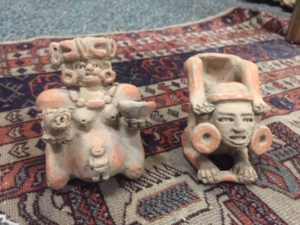 JE sent me a photo of two Pre-Columbian pottery figures. They appear to come from the Nayarit culture in West Mexico, 100 BC to 250 AD. I say they “appear” Pre-Columbian because an appraiser can never feel sure about photos of such objects. However, these wonderful figures, from a genre called Pre-Columbian or more appropriately termed today ‘Pre-Hispanic,’ present several problems regarding authentication, legality, and value. A major issue is the grave-robbing aspect of their discoveries. Often tomb–looters once offered these kinds of figures on the market in the 1930’s. With a proven value fakes became to appear. Diego Rivera, a major collector among others in the 1930’s, created this market.
JE sent me a photo of two Pre-Columbian pottery figures. They appear to come from the Nayarit culture in West Mexico, 100 BC to 250 AD. I say they “appear” Pre-Columbian because an appraiser can never feel sure about photos of such objects. However, these wonderful figures, from a genre called Pre-Columbian or more appropriately termed today ‘Pre-Hispanic,’ present several problems regarding authentication, legality, and value. A major issue is the grave-robbing aspect of their discoveries. Often tomb–looters once offered these kinds of figures on the market in the 1930’s. With a proven value fakes became to appear. Diego Rivera, a major collector among others in the 1930’s, created this market.
Looted effigies such as these seem onerous because they separate the figures from time and location, and their own culture. The second major problem is that many fakes emerged on the market over the entire 20th century. Faked effigies present their own problems. Studios in Mexico in the 20th century actively ‘reproduced’ these figures, sometimes with the intention to deceive. They may look old, but erosion and patina blemishes are also “faked.”
At a recent auction offering a large collection of Pre-Hispanic figures experts discovered that half of the collection was faked. And this in the collection of a knowledgeable collector in Switzerland. To ascertain if figures are modern creations, experts compare factors such as size, limb proportions, polish, and garments, as well as stylistic themes.
Culturally Sensitive
I mentioned cultural sensitivity as the other problem with these figures. Many were “found” in Mexican shaft tombs. Archeologists say, once unearthed, they lose touch with their importance. In the past art collectors valued them for their style. So these two worlds have never agreed on who should collect, and what they should collect. And of course, many were illegally sourced, and impossible to sell openly, so that these beauties remain ‘silent.’ Some of my clients cannot sell for fear of exposure.
I find the years these figures spent in shaft tombs most interesting. These tombs are unique to Colima, Jalisco, and Nayarit. The tombs held the deceased elites of the culture, and generations of their families, and sometime reached 60 ft. deep. The bottom of the shaft might open to multiple caverns. Explorers found other objects in the tombs, such as shell jewelry, household things like fabric-making tools, food, and conch shell trumpets.
Third Problem
Scholars call these tomb figures ‘effigies’. Terracotta was fired from a mellow light tan to orange to brown/black slip, then burnished to polish. These effigies were created during a long cultural period, 300 BCE to 400 CE. Sadly, because many became looted, provenance is hard to determine and authentication difficult. All these factors affect value. Plus a third factor, the illegality of the sourcing, weighs heavily over the whole market. The International Council of Museums stated in 2008 that 90 percent of the clay figures came from illegal evacuations.
A very new area of scholarship.
In 1993 a team of experts finally “legally” investigated an entire shaft tomb. We know little about the cultures who first dug these tombs. 1998 saw a major museum exhibition held, Ancient Mexico: Art and Archaeology of the Unknown Past.
Since they found these effigies in tombs, scholars don’t know if ancient people made them for the burial, or if they buried objects loved by the deceased in life.
I find it touching that two style of figuration predominate:
- Representation of dogs, in many cultures considered guides to the underworld
- Figures of couples either joined together, or created as a pair
These female and male figures are either ancestor, or marriage pairs, conveying subtle devotion. If created to represent ancestors, they were welcomed into shaft tombs that contained whole generations over times.
JE, let’s assume your Pre-Columbian figures are old, legal, and original
What are they worth? In good condition, they might bring $800-1,200 each. Some of the older, rarer pieces are worth thousands of dollars. Fakes are worth little. A good place to find out if they are marketable is to contact Skinner Auctions in Boston. You might ask Skinner to quote you an auction estimate, and for that, there’s no charge. However, this might require a trip to Boston for authentication. I advise my clients to KNOW how they acquired these effigies, and bring proof.
Hi I need help with identifying a very old pot I got from an old lady. The pot really looks ancient